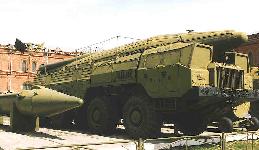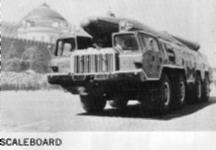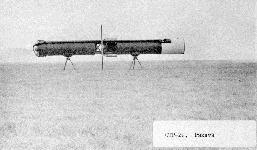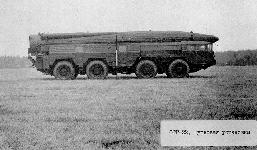




The SS-12 SCALEBOARD uses the same MAZ-543 (8x 8) chassis as the SCUD-B. The primary recognition difference is the environmental protective container that completely encloses the SCALEBOARD missile. The missile is a liquid-fuel, single-stage system similar to the SCUD, but with greater range (900 km), accuracy, and size of warhead. Like the SCUD, the SCALEBOARD is designed to be fired from a pre-sited position, then moved to another prearranged position. The MAZ-543 has centralized tire pressure control.
The SCALEBOARD is a front and theater-level weapon system that gives the Soviet commander a nuclear capability. The SCALEBOARD appeared deployed only with Soviet forces. The mid-range missile can be stationed in the western part of the USSR and still be able to hit important targets in Central Europe.
The SS-12 SCALEBOARD, in service since the mid-1960s, was replaced beginning in 1979 with a new missile that had the same range (900 km) with improved accuracy. Initially considered to be a new missile, designated the SS-22, the SS-12M SCALEBOARD B [also known as the SS-12B and the SS-12 mod 2] was subsequently assessed as an improved version of the earlier Scaleboard. By the early 1980s the Soviets were replacing older shorter-range Scaleboard missiles with SS-22s, and were developing the new SS-23 as a follow-on to the Scud missiles. The SS-22 missile had the range to cover a substantial portion of NATO Europe even from its deployment areas within the Soviet Union.
The Intermediate-Range and Shorter-Range Nuclear Forces [INF] Treaty was signed on 08 December 1987 and entered into force on 01 June 1988. The fundamental purpose of the INF Treaty was to eliminate and ban US and former USSR (FSU) ground-launched ballistic and cruise missiles, as well as associated support equipment, with ranges between 500 and 5500 kilometers. SS-12 and SS-23 transporter-erector-launcher (TEL) vehicles were eliminated at Stan'kovo. The first Soviet SS-12 missile was eliminated at the Saryozek Missile Elimination Facility on 01 August l988. The last of 718 Soviet SS-12 missiles was eliminated at the Saryozek Missile Elimination Facility on 25 July 1989.
In February 1997 a top Cuban military defector, Alvaro Prendez, alleged that Cuba was developing biological weapons were to be delivered by five Soviet-made SS-22 missiles that were deployed near the central city of Santa Clara. Prendez and other defectors had heard rumors that the missiles were shipped from Russia to Cuba as late as 1991. Cuba is not known to have any SS-22 missiles, and these claims appear unfounded.Specifications | ||
| USA Code Name | SS-12 | |
| Nato Code Name: | Scaleboard | |
| Russian Designation: | 9M76 | |
| Contractors |
Nadiradze OKB (design bureau) Votkinsk (missile) Barricade factory, Volgograd, Russia, (TEL) |
|
| Stages: | 1 | |
| Fuel: | Liquid | |
| Inservice: | 1969 | |
| weight | 9,700 kg | |
| length | 12.4 m | |
| diameter | 1.01 m | |
| Range: | 800 km - Mod 1 900 Km - Mod 2 |
|
| Guidance | inertial | |
| Circular Error Probable (CEP) | 0.4 nm / 0.75 km - Mod 1 0.2 nm / 0.37 km - Mod 2 |
|
| Warhead | 500-kiloton nuclear | |





